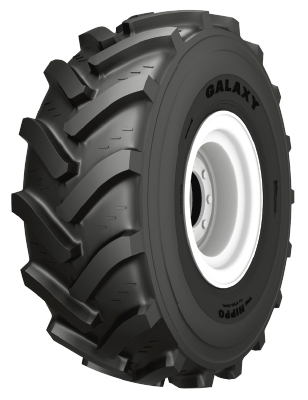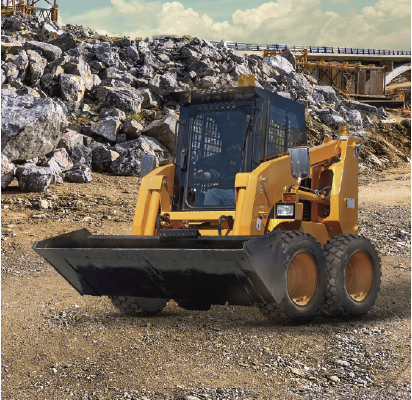When the product development team at Yokohama Off-Highway Tires (YOHT) sat down at the drawing board to develop a new skid steer radial, they didn’t sit down alone—they were in close contact with skid steer operators and commercial tire dealers, who provided deep insight into what the ideal skid steer radial would be. The result was the Galaxy AT Grip Steel, a bold new tire for a complex market.
The AT Grip Steel is recognizable at a distance, thanks to its unique tread design that combines two rows of chevron-shaped blocks along the centerline with curved lugs and open shoulders. That pattern—unusual for a skid steer tire—illustrates the challenge facing tires that often have to be all things to all operators.

Galaxy Hippo all-steel radial
VERSATILE TIRE
“Skid steers are so versatile that they get used in a huge variety of applications and settings,” notes Dhananjay Bisht, national product manager—earthmoving, construction and industrial tires for Yokohama Off-Highway Tires America, Inc. “That makes them extremely challenging from a tire perspective. Operators expect their skid steer tires to provide a comfortable ride but also remain very stable under heavy loads, deliver excellent traction while running smoothly on pavement, and resist cuts and chunking while also being hard enough to withstand constant abrasion from hard surfaces and the unique skidding action of the machine. It is a lot to ask for from a tire, and requires great creativity in design and manufacturing.”
Each of those contrasting challenges requires careful balancing during the development stage, Bisht points out.
“The tread pattern of the Galaxy AT Grip Steel walks the line between densely placed blocks in the center for stability and wear resistance and the voids along the shoulders that allow the tire to grip in looser conditions,” he explains. “The tread compound is a carefully balanced combination of many ingredients, formulated to resist wear while also withstanding damage from sharp items like rocks or scrap metal.”
DURABILITY IS KEY
With the increasing use of skid steers in construction and farm applications, puncture damage and sidewall cuts are a bigger threat than ever to skid steer tires. Yokohama OHT designed the Galaxy AT Grip Steel with steel belt reinforcement, making the new tire three to four times more resistant to tread puncture than comparable bias-ply tires.
The AT Grip Steel also includes an extra sidewall ply and cast rim guards and ribs for added sidewall protection. Constructing such a durable casing allows owners to re-tread their AT Grip Steel tires, reducing the total cost of ownership.
SPECIAL SIDEWALLS
Yokohama Off-Highway Tires was committed to creating the AT Grip Steel as a radial tire. Because radial plies run at 90-degree angles from one bead to the other and are wrapped in circumferential belts, radial tires create a bigger, flatter contact patch with more even load distribution. The result is better traction and slower wear than bias-ply tires, which tend to concentrate weight and wear in the center of the tread. In fact, in wear trials, the AT Grip Steel lasted nearly 50% longer than leading bias-ply skid steer tires.
Radials also experience less heat buildup—critical for long-lasting performance on equipment that operates on long cycles or for long hours—and deliver better comfort and fuel efficiency.
However, skid steer experts were quick to insist that the new tire’s sidewalls should not be too flexible. Stability is essential for skid steers, especially when carrying heavy attachments or loaded buckets.
Bisht says Yokohama Off-Highway Tires engineers extended the turn-up around the bead—the loop created by a heavy rubber ply that covers more of the sidewall—and developed a flex-dampening ring to add even more reinforcement and stiffness. The flex-dampening ring diverts much of the natural sidewall flexion to the area closest to the ground, allowing the footprint to expand while maintaining greater stability in the sidewall.

NEW LOADER RADIAL
Yokohama OHT used many of the lessons learned from developing the AT Grip Steel as it created the new Galaxy Hippo all-steel radial for the global front-end loader market. Like skid steers, loaders are increasingly used in a wider range of applications than ever before, creating a need for tires that can handle extra demands for traction.
“When we think of loader tires, most of us immediately imagine a rock tread,” says Bisht. “But we realized that there are thousands of front-end loaders being used in dirt and sand on construction sites and mining applications, and thousands more on farms, where they do everything from maintenance in fields to packing down massive piles of vegetation in huge feed bunkers. We created the new Galaxy Hippo radial for those loaders.”
As with the AT Grip Steel, radial construction was the starting point for the new Hippo, which the company developed to build on the long-standing success of the bias-ply Galaxy Hippo.
“Radial tires excel where equipment is operating in long cycles or for hours at a time,” Bisht points out. “Radials have less of a tendency to build up heat under those conditions, and all-steel construction is more efficient at dissipating heat that does get generated by the movement of the tire. Radials provide a more comfortable ride, which enhances productivity. They last longer than bias-ply tires, and they are more fuel efficient, both of which show up quickly on the bottom line.”
BIGGER FOOTPRINT
Many of the performance benefits of radial tires start with their larger footprint and more even load distribution compared to bias-ply tires.
Like the AT Grip Steel, Yokohama OHT designed the new Hippo radial to walk a careful balance between the advantages of large, evenly distributed radial footprints and the need for sidewall stability. The Hippo all-steel radial has a footprint 6% larger than its same-sized bias-ply counterpart, putting more rubber in contact with the ground and more evenly distributing load across each lug.
EXTRA TRACTION
Yokohama OHT designers thickened the lugs of the Galaxy Hippo radial and steepened their curves to optimize traction while improving their durability. The Hippo radial’s lugs are nearly perpendicular toward each edge of the tread, maximizing the grip of the tire’s shoulders. Toward the center of the footprint, the lugs’ angle becomes more-shallow and their noses are widened.
The design team also increased the overlap of the center portions of the lugs to deliver a smoother ride and more reliable steering. The denser centerline formed by wider, overlapping lug noses also reduces wear on hard surfaces. Roading is an increasingly important feature for some loader tire buyers, Bisht notes, which is why the Galaxy Hippo radial was designed for good road handling at speeds of up to 25 mph.
“We pride ourselves on developing tires that are purpose-built for the challenges that equipment operators face in the real world,” says Bisht. “That’s a reflection on the fact that no single tire can be all things to all people. But with the Galaxy AT Grip Steel and the Galaxy Hippo all-steel radial, we’ve tapped the best of tire design, engineering, materials and manufacturing to get very close.”
About the Author:
Bruce Besancon is vice president of marketing for Yokohama Off-Highway Tires America, Inc. With more than 30 years of experience in the OTR Tire Business, Bruce has been involved in every aspect of bringing OTR tires to the mature North American market. From product development, testing and release to generating product awareness programs and campaigns, and a little of everything in between, Bruce is one of the OTR industry’s most knowledgeable players. For more, visit www.yokohama-oht.com.
Modern Contractor Solutions, March 2023
Did you enjoy this article?
Subscribe to the FREE Digital Edition of Modern Contractor Solutions magazine.



